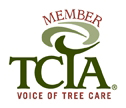|
Climbing Spikes Damage Live TreesClimbing spikes are the tools arborists use when climbing trees they are removing. They are sometimes called tree spikes, gaffs or spurs. Whatever you call them, they are not intended for use when pruning a live tree. Use of tree spikes can damage a live tree in a number of ways. Climbing spikes needlessly create holes in trees. These holes damage some of the vital tissue of the tree, called cambium. The wounds may encourage the growth of unwanted shoots, called watersprouts. The holes allow a site of entry for wood decay organisms. It is also possible for infected climbing spikes to transfer some disease organisms from diseased trees to healthy trees, much the same way the common cold can be spread from person-to-person. In addition to health concerns for the trees, the holes that climbing spikes leave are just plain unsightly and can diminish the dollar value of your trees! This information is not new even though some inexperienced and/or unprofessional tree care workers continue to use climbing spikes when climbing trees that they only intend to prune. In fact, it has been known for well over 100 years that tree spikes should not be used when pruning a tree.
"Climbing spurs should never be used by good workmen. Wounds made by the sharp iron teeth of this tool encourage the growth of injurious side shoots on the trunks, and leave defects in the wood which never disappear and diminish its value.” Just imagine what your trees will look like after years of abuse during pruning using tree spikes. Oh, you may hear arguments that it’s quicker and easier and less costly. In the short run, that may be true, but in the long run, using spikes to ascend while pruning does irreparable damage to your trees.
To Home Page from Climbing Spikes Page
 Custom Search |

